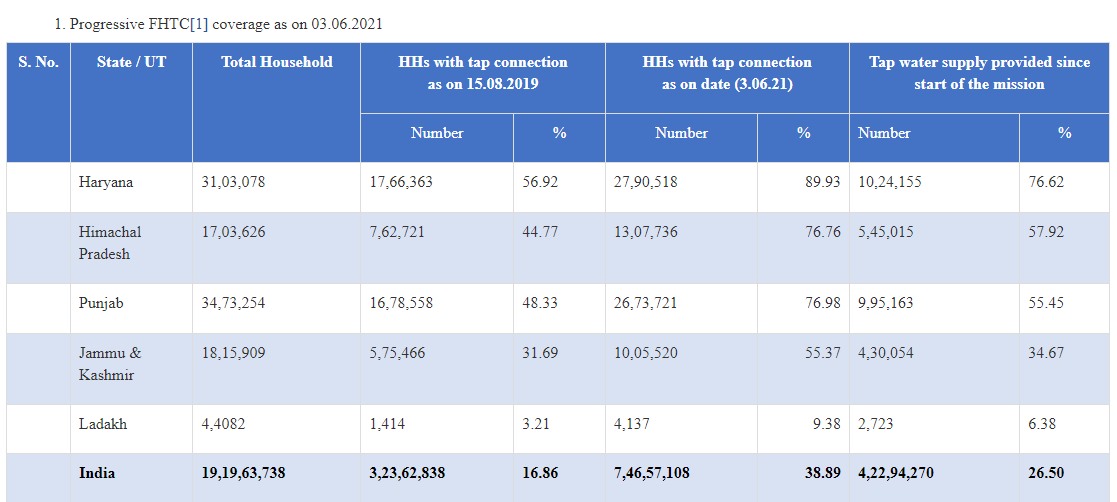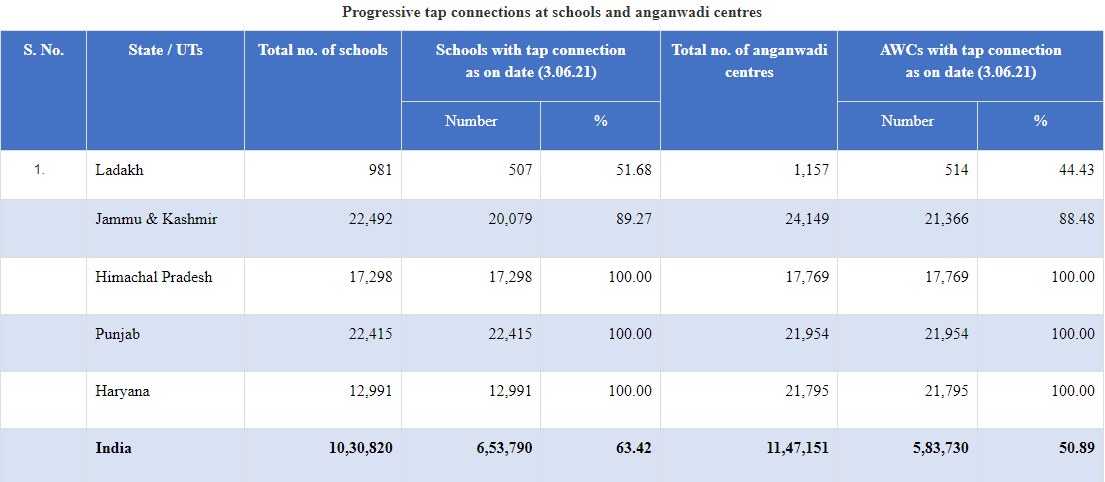Punjab, Haryana, Himachal, J&K and Ladakh to get tap water connection by 2022
The plan to provide every rural household in Punjab, Haryana, Himachal Pradesh, Jammu & Kashmir and Ladakh with tap water connections by 2022, will benefit more than 50 million people in rural areas, especially women and girls.


The supply of potable tap water in every home will improve the lives of women and girls. Photo: Shivani Gupta
On June 5, the Union Ministry of Jal Shakti announced that the Jal Jeevan Mission in Punjab, Haryana, Himachal Pradesh, Jammu & Kashmir and Ladakh will achieve ‘Har Ghar Jal’ status by 2022, two years before the national target of 2024.
In order to make this happen, Union Minister of Jal Shakti Gajendra Singh Shekhawat, approved an allocation of Rs 8,216.25 crore [Rs 82,162.5 million] in 2021-22. This is more than four times the allocation to these states and UTs in 2020-21.
According to the ministry, the supply of potable tap water in every home will improve the lives of more than 50 million people living in villages in this region, especially women and girls.
Women in rural India are often the primary providers of water for their families. For over years, they have been burdened with the task of fetching water. A survey by Gaon Connection last year found that in 38 per cent of rural households women had to travel extra to meet the additional water needs of the family.
Also Read: About 40% women in rural households work harder to fetch water in the COVID-19 lockdown
Two years ago, in 2019, Prime Minister Narendra Modi announced the Jal Jeevan Mission (JJM) to provide safe piped drinking water to every rural household in the country by 2024.
At the time of announcement of the scheme, only 4.78 million rural households in these states and UTs had tap water supply. According to the ministry, more than 2.9 million tap water connections were added to the number in 21 months.

Haryana
Before the announcement of the scheme, only 57 per cent of the total 3.1 million households had piped water connections. However, now 91.32 per cent of rural homes in the state are getting tap water supply.
Himachal Pradesh
Over 76 per cent of rural homes in the state have tap water supply. In 2021-22, Himachal Pradesh plans to provide tap water connections to 208,000 households and the remaining 194,000 households will be connected in 2022.
Punjab
As per the Union Jal Shakti Ministry, over 77 per cent of rural households in Punjab are getting tap water supply. Under the Jal Jeevan Mission, in 2021-22, tap water connections will be provided to 887,000 more households.
The ministry claims that the state has sufficient funds to meet its target by 2022.

Jammu & Kashmir, Ladakh
In Jammu & Kashmir, 55.7 per cent of rural households are getting tap water supply. It has planned to provide tap water connections to 491,000 households in 2021-22 and to 327,000 households in 2022-23.
Ladakh has planned to provide tap water connections to 28,788 households in 2021-22 and 11,568 households in 2022-23. This, despite the challenges of difficult terrain, adverse weather and sparsely located habitations, said the ministry’s press release.
100% tap water coverage in anganwadis
To ensure safe drinking water for children in schools and anganwadi centres, PM Modi announced a 100-day campaign that was launched on October 2 last year. The three states of Haryana, Himachal Pradesh, and Punjab have already provided tap water connections to all schools and anganwadi centres. The Union Territories of Jammu & Kashmir and Ladakh are expected to do so soon.

In February when the Budget for the next fiscal 2021-22 was announced, there were reductions in the funds for anganwadis under the Integrated Child Development Services (ICDS). Data by the Union Jal Shakti Ministry during that period showed that only 39.8 per cent of anganwadis across the country had tap water connections. But, despite poor infrastructure and lack of basic facilities, such as tap water, the Budget for the anganwadis was reduced.
The Union Budget 2021-22 document shows the combined budget allocated for the Saksham scheme (which includes schemes such as ICDS, Poshan, creches, and schemes for adolescent girls), is Rs 201,050 million. This is even less than Rs 205,320 million given to ICDS alone in 2020-21.
However, the ministry claims the ‘massive’ increase in allocation [Rs 82,162.5 million for five states and UTs], and speed of implementation will help achieve the target of ‘Har Ghar Jal’ status by 2022 in Punjab, Haryana, Himachal Pradesh, Jammu & Kashmir, and Ladakh.

